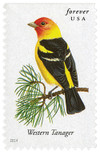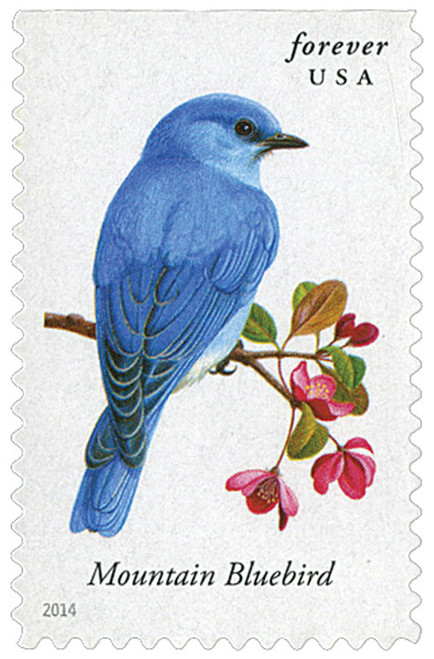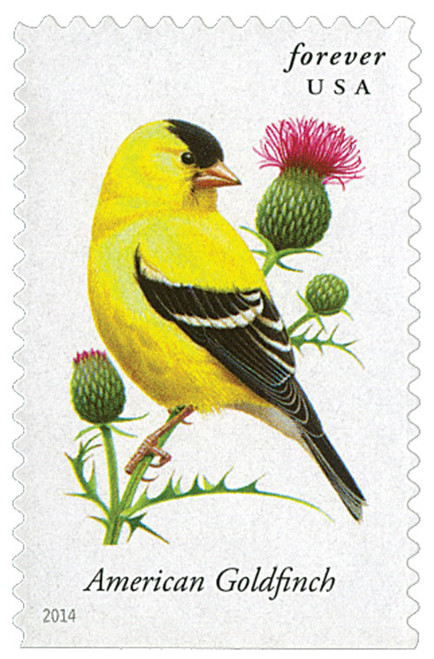
# 4884 - 2014 First-Class Forever Stamp - Songbirds: Western Tanager
US #4884
2014 Western Tanager – Songbirds
- Pictures a western tanager
- One of 10 stamps picturing different species of songbird
Stamp Category: Commemorative
Set: Songbirds
Value: 49¢ First Class Mail Rate (Forever)
First Day of Issue: April 5, 2014
First Day City: Dallas, Texas
Quantity Issued: 400,000,000
Printed by: Ashton Potter (USA) Ltd.
Printing Method: Offset
Format: Double-sided Booklets of 20
Tagging: Nonphosphored Type III, Overall Tagged
Why the stamp was issued: To commemorate the western tanager and its unique song.
About the stamp design: Pictures a painting of a western tanager perched on an evergreen branch. Artwork by Robert Giusti. The stamp also includes the species’ common name.
First Day City: In addition to the Dallas, Texas, First Day of Issue city, there was also a First Day of Sale ceremony held at the Philadelphia National Stamp Exposition in Oaks, Pennsylvania. They offered two different pictorial postmarks: one from Oaks and one from nearby Audubon, Pennsylvania. The pictorial cancels were designed by the American First Day Cover Society.
About the Songbirds set: Issued to commemorate the many species of songbirds that call America home and fill the air with the sounds of their unique tunes. Includes 10 different designs, each picturing a different species of songbird and its’ common name: western meadowlark, mountain bluebird, western tanager, painted bunting, Baltimore oriole, evening grosbeak, scarlet tanager, rose-breasted grosbeak, American goldfinch, and white-throated sparrow. In addition to the birds themselves, the stamps also picture different plants (often found in the birds’ natural habitats) acting as perches. Designs were created from paintings by Robert Giusti.
History the stamp represents: The medium-sized, migratory western tanager, once classified in a mostly tropical bird family and now considered part of the cardinal family, is common in much of western North America. The summer breeding months are spent as far north as southern portions of Canada’s Northwest Territories. Migration can take the species as far south as Central America in the winter months.
The western tanager prefers coniferous forests for breeding, starting as early as mid-April each year. As is common with many songbirds, the male arrives in advance to establish and defend the nest site. He and the female will form a bond, without any showy courtship. The male then guards and feeds the female as she makes a nest high in the branches.
During breeding season, the male western tanager displays striking red head feathers. While most tanagers can produce their red color internally, the western tanager needs an additional external substance to create the red pigment. This chemical can be found in certain evergreen needles, which are consumed by insects that the tanger eats.
Scientists believe brighter red feathers of a western tanager may indicate a superior mate. The redder his crown, the more successful an insect hunter he must be and the more attractive he will seem.
US #4884
2014 Western Tanager – Songbirds
- Pictures a western tanager
- One of 10 stamps picturing different species of songbird
Stamp Category: Commemorative
Set: Songbirds
Value: 49¢ First Class Mail Rate (Forever)
First Day of Issue: April 5, 2014
First Day City: Dallas, Texas
Quantity Issued: 400,000,000
Printed by: Ashton Potter (USA) Ltd.
Printing Method: Offset
Format: Double-sided Booklets of 20
Tagging: Nonphosphored Type III, Overall Tagged
Why the stamp was issued: To commemorate the western tanager and its unique song.
About the stamp design: Pictures a painting of a western tanager perched on an evergreen branch. Artwork by Robert Giusti. The stamp also includes the species’ common name.
First Day City: In addition to the Dallas, Texas, First Day of Issue city, there was also a First Day of Sale ceremony held at the Philadelphia National Stamp Exposition in Oaks, Pennsylvania. They offered two different pictorial postmarks: one from Oaks and one from nearby Audubon, Pennsylvania. The pictorial cancels were designed by the American First Day Cover Society.
About the Songbirds set: Issued to commemorate the many species of songbirds that call America home and fill the air with the sounds of their unique tunes. Includes 10 different designs, each picturing a different species of songbird and its’ common name: western meadowlark, mountain bluebird, western tanager, painted bunting, Baltimore oriole, evening grosbeak, scarlet tanager, rose-breasted grosbeak, American goldfinch, and white-throated sparrow. In addition to the birds themselves, the stamps also picture different plants (often found in the birds’ natural habitats) acting as perches. Designs were created from paintings by Robert Giusti.
History the stamp represents: The medium-sized, migratory western tanager, once classified in a mostly tropical bird family and now considered part of the cardinal family, is common in much of western North America. The summer breeding months are spent as far north as southern portions of Canada’s Northwest Territories. Migration can take the species as far south as Central America in the winter months.
The western tanager prefers coniferous forests for breeding, starting as early as mid-April each year. As is common with many songbirds, the male arrives in advance to establish and defend the nest site. He and the female will form a bond, without any showy courtship. The male then guards and feeds the female as she makes a nest high in the branches.
During breeding season, the male western tanager displays striking red head feathers. While most tanagers can produce their red color internally, the western tanager needs an additional external substance to create the red pigment. This chemical can be found in certain evergreen needles, which are consumed by insects that the tanger eats.
Scientists believe brighter red feathers of a western tanager may indicate a superior mate. The redder his crown, the more successful an insect hunter he must be and the more attractive he will seem.














